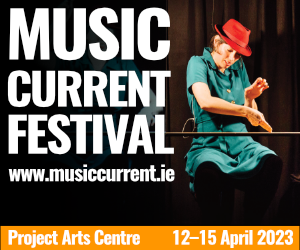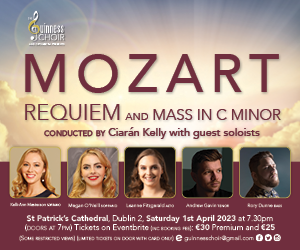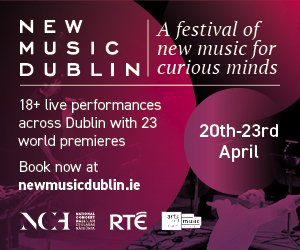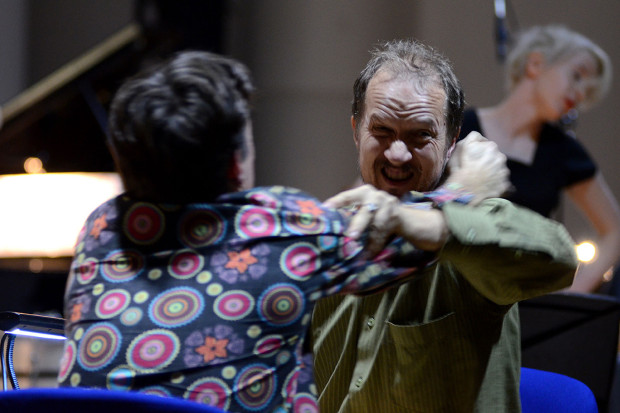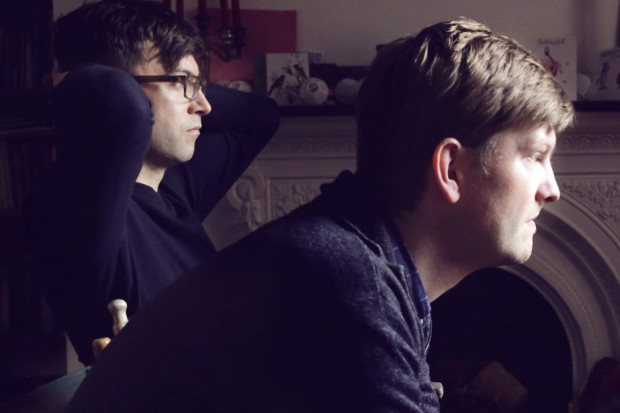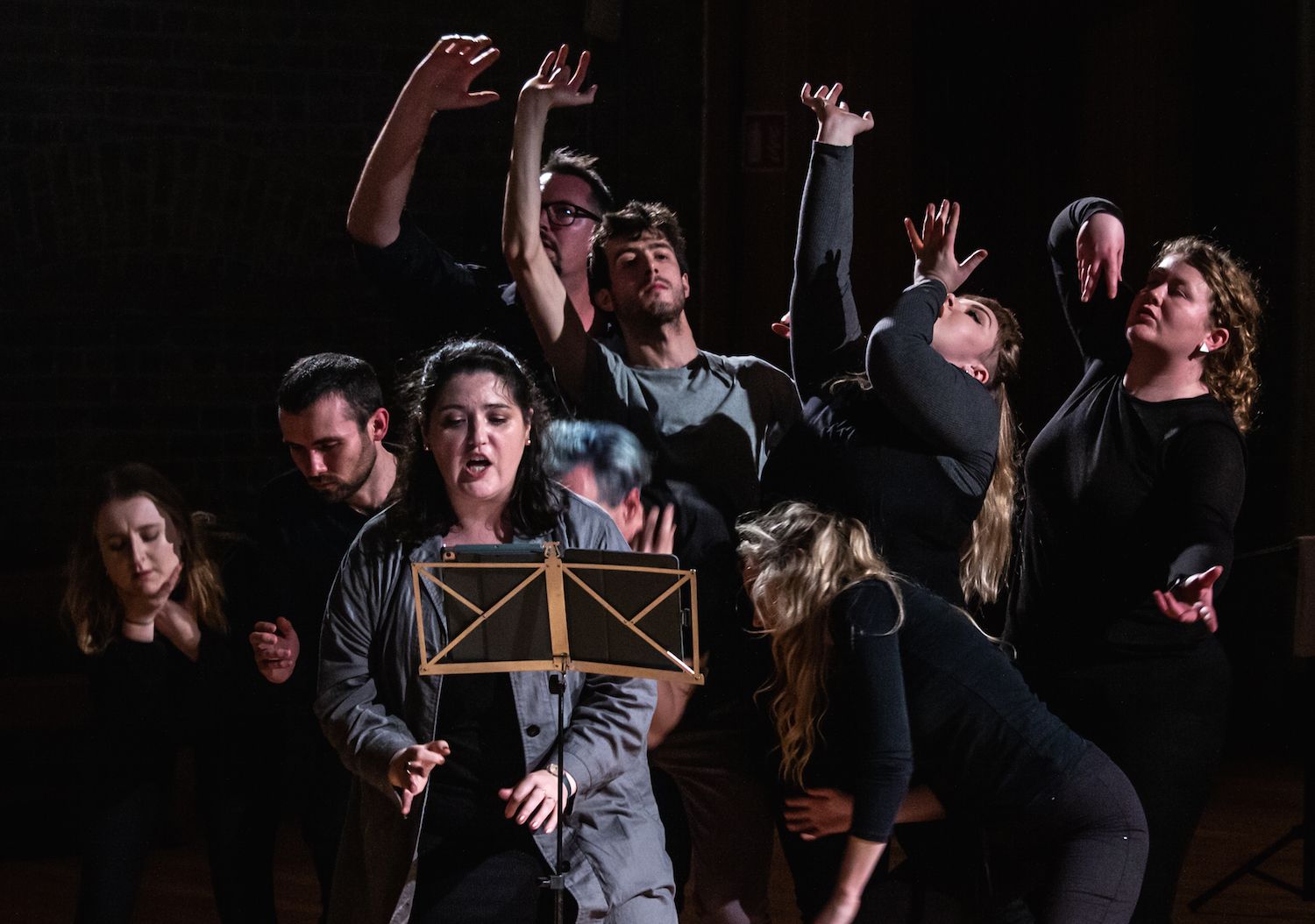
Michelle O’Rourke with Tonnta and Kirkos performing ‘O’ROURKE’ by Andrew Hamilton at Listening Bodies (Photo: Borg Dóra Benediktsdóttir)
Dance Moves in the Banquet Hall
It began with Robbie Blake running determinedly on the spot and concluded with Michelle O’Rourke lying prone on the floor while negotiating the vocal gymnastics of Andrew Hamilton’s O’ROURKE with aplomb. Between these two points fell the four hours of the Tonnta-Kirkos co-production Listening Bodies, the latest in Kirkos’ series of events channelling the spirit of the 1960s Fluxus movement. A variety of performances and installations were spread across the various spaces in Smock Alley Theatre. These were generally timed to allow the audience to catch events sequentially, though for some reason, at two points in the evening (6:15pm and 7pm), events were programmed simultaneously in different spaces leaving audience members to decide which event they would miss. Whereas most artists were represented by one piece generally of short duration, Kirkos co-directors Robert Coleman and Sebastian Adams were represented by, in Coleman’s case, one piece and one installation, and in Adams’ case, by two related installations, a third installation co-created with Jonathan Nangle, and three further compositions, two of which were solo performances.

Michelle O’Rourke, Tonnta and Kirkos in Andrew Hamilton’s O’ROURKE (Photo: Borg Dora Benediktsdóttir)
Music stand instructions
Running through the entire evening, and perhaps the reason why it was decided to give the production a four-hour duration, was Robbie Blake’s Vexations. Music stands were splayed across the width of the Banquet Hall, each one carrying an instruction regarding how a person was to perform. At the first stand, performers had to jog on the spot, and at others they intoned sounds, danced, ripped up paper, drew on a notepad and so on. Performers logged the amount of actions they completed and in a nod to Satie the target they planned to reach before the close of the event (which they actually exceeded) was 840 separate actions. The piece with its physical demands was probably considerably more vexatious for the performers than for any audience member and while the dancing position produced some impressive moves it was notable that some performers tended to dodge this stand as the evening progressed. In some ways the piece was quite revealing as it tended to exaggerate the constructed public personas of the performers.

Jane Hackett performing Vexations by Robbie Blake (Photo: Borg Dora Benediktsdóttir)
Of the various pieces by Adams, two were particularly notable. In Weight Piece he played a drone on the viola while coat hangers were added to each end of his bow. It was all somewhat reminiscent of a weightlifter gradually adding extra kilos to their barbell and the sounds of the viola as the bow pressure increased were perhaps not that different to a weightlifting session either. Masturbate Piece, a ten-minute quiet work for mixed ensemble with sporadic counting out loud from Blake created a pleasantly somniferous atmosphere, the individual noodling lines allegedly created from ‘transcriptions’ of the performers masturbating. Coleman’s Double Triptych involved simultaneous performances in the Banquet Hall and the Main Space. Experiencing the performance from the Main Space, the music alternated between repetitive gestures for voice and violin (to what seemed to be a nonsense text) and live sounds of the simultaneous performance, which drifted down from the Banquet Hall through the open door. These sounds were amplified slightly by a feed to a speaker set at a low level creating a weird sonic mix. I got the impression that those in the Banquet Hall may have had the more interesting experience but by being in the Main Space I got to witness one of the more eccentric moments of the evening. It is a very welcome, if rare pleasure to hear a live performance of music by Karol Szymanowski in Ireland, but quite what a piece by him was doing in the midst of all this contemporary work was hard to figure out. The fact that his ‘Fontaine d’Arethuse’ from the Mythes was performed by Jane Hackett as a solo violin piece without piano made the whole experience rather more bizarre.
Oasis of melody
Of the other pieces encountered, a number stood out. Kelly Marie-Murphy’s Book of Elegant Feeling was a rather romantic solo cello work, played with intense concentration despite the surrounding distractions by Yseult Cooper-Stockdale, and contrasted strongly with most of the rest of the proceedings. It was fascinating to observe how Jonathan Nangle’s beguiling Vivid Trace for toy piano and mechanical music box not only drew in the audience, but like a tintinnabulating pied piper lured performers away from Blake’s Vexations at the opposite end of the Banquet Hall and into the huddled circle around the piano. Blake brought the necessary flair, abandon and wit to a performance of Jennifer Walshe’s Folk Songs Collection Volume 2, leaving one wishing that the performed selection had been longer. For those of us who managed to belt up the stairs before the conclusion of Adams’ Omegle Piece in the Main Space to the Banquet Hall, Garrett Sholdice’s I have heard the talkers provided a warm oasis of melody, sung with velvety tone by a perambulating O’Rourke. Its short duration and the timetable clash meant that quite a number of people missed this. Laura Steenberg’s Piriforms for four voices grouped in overlapping pairs singing four partials while changing vowel sounds, performed by a group in the foyer, couldn’t but remind one of Stockhausen’s Stimmung, which was recently presented by Tonnta at City Hall, Dublin.

Robert Coleman performing Vivid Trace by Jonathan Nangle ((Photo: Borg Dora Benediktsdóttir)
Overall there was a feeling that much of the work was placed almost at random in the various venues rather than being carefully designed for the Smock Alley or even using the space in the most effective way. Seán Ó Dálaigh’s Sonic Landscapes looked a bit lost on the vast white walls of the Banquet Hall but Fiona Reilly’s Declarations of Time Spent (which doubled as an installation and text piece) worked better in the space and provided considerable amusement. Eva-Maria Houben’s Ein Tönig suffered from being in the noisy Boys School rather than in the quieter Main Space, as isolated iterations of a single pitch were interspersed with audience members negotiating the creaking wooden ramp and traffic sounds from outside. The same issue affected Peter Ablinger’s Whitish, though here the loss was more negligible as the content of the work (performers gently rubbing cardboard boxes with cleaning pads) did nothing to justify the 45 minutes that it had been given in the schedule and it merely resulted in a noisy exodus of the audience. During this performance, some audience members were also handed a ‘thinking piece’ that included phrases such as ‘Listen to the sounds. Hear the changes if there are any. Listen in your mind’s ear,’ which, depending on your mindset, either added to the profundity or risibility of the performance. By eliminating the Ablinger and tightening up some of the other gaps in the schedule, the performance could probably have fit comfortably into a three-hour slot. Overall, while Tonnta and Kirkos are to be congratulated for putting together an experience unlike most other contemporary music events in the year, one felt that the endeavour would have benefited had a decision not been taken to limit the contributions of Irish composers not directly associated with the host ensembles to extremely short works. The addition of some larger pieces of substance to the line-up would have given the evening a stronger sense of ambition and a less ephemeral feel.
Kirkos’ next event is the Irish premiere of the opera The Buffer Zone by Cypriot composer Yannis Kyriakides on 6-8 December at the DCC Incubation Space. For more on Tonnta, visit http://tonnta.ie.
Published on 14 November 2019
Mark Fitzgerald is a Senior Lecturer at TU Dublin Conservatoire.







